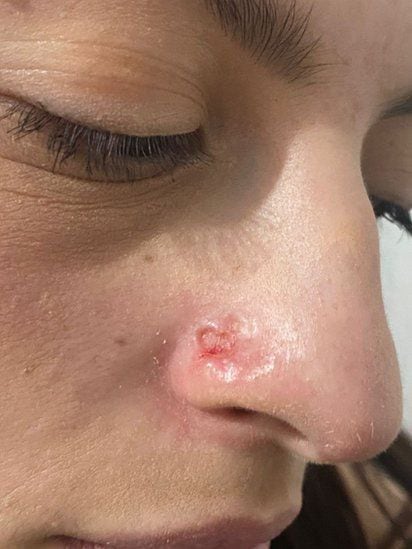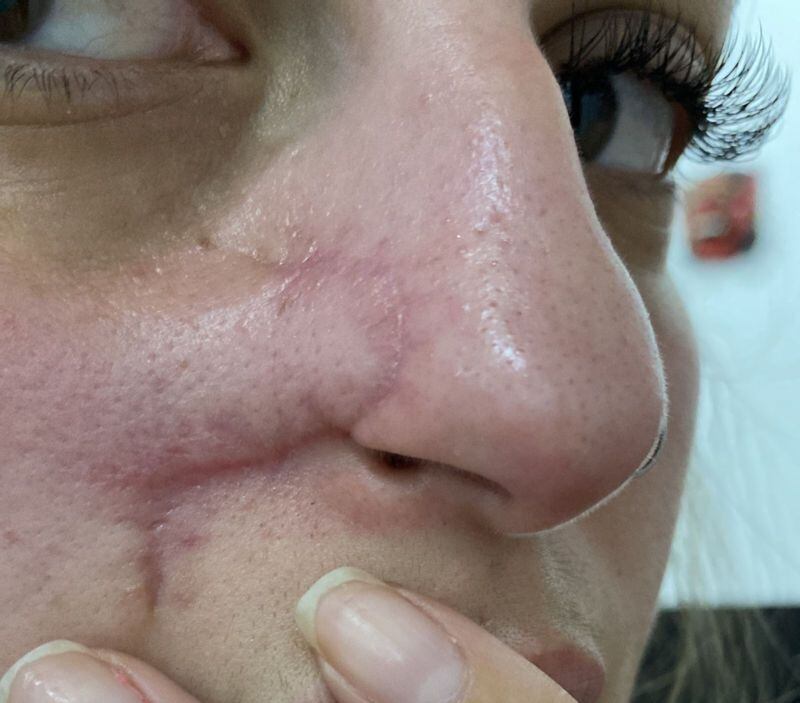Days before traveling to Sao Paulo, Daiane Lima, a 27-year-old woman, decided to have a facial. Little did she know that the procedure to clean her pores and reduce fat on her face would help her discover skin cancer.
Lima says that she gets facials regularly and, in mid-2022, she scheduled the procedure again with a beautician from Erechim, the city where she lives. However, after the procedure, she says she noticed that the area near her nose was tender.
LOOK: A powerful El Niño phenomenon is forming: The “inexplicable” warming of the oceans that alarms scientists
“After a few days, there was a small wound, but I assumed it was because I had a blackhead removed or something, and I started using a healing ointment,” she recalls.
Lima, who works doing piercings, details that in the following weeks the wound healed, but then did not completely disappear. She stayed like that for a little over a month.. And it was after bleeding that he realized the injury.
“I woke up and my nose was bleeding a lot. That’s when I decided to make an appointment with a dermatologist,” he says.
Since she does not have health insurance, the young woman, who is self-employed, had to use her savings to pay for a private consultation. And it was on the first visit to the doctor when the suspicion arose that the sore on the nose that did not heal could actually be skin cancer.
“When the doctor talked about this possibility, I burst into tears. You think of a thousand things. As I was young and there were no cases of skin cancer in the family, I never imagined that this could happen to me. My world fell apart at that moment” , says the young woman.
The biopsy result confirmed that Lima had basal cell carcinoma, a type of skin cancer, and that he would have to undergo surgery to remove it.
Last January, he underwent surgery and part of the skin on his face was removed to remove the tumor. She needed 27 stitches and was out for two months. Her diagnosis also caused the young woman to postpone the last semester of her History degree.
“My life changed completely from one day to the next. It is not only about the diagnosis, but about all the consequences that it entails. In addition to paralyzing the university and work, there is also the question that it affects self-esteem, especially since my cancer is on the face, a very visible place, “he recounts.
In addition to the mark on the skin, Lima says that the cancer also caused a crisis of anxiety and depression.
“My self-esteem was over. I couldn’t look at myself in the mirror and I avoided going out. Everyone was asking me what I had done and why I had a scar. I didn’t leave the house for a long time because I didn’t want to be seen. Not to mention that people make jokes that hurt me, like calling me fat. They have no idea why my body is like this,” she says, noting that the medications led to her gaining weight.
What is basal cell carcinoma?
According to the National Cancer Institute of Brazil (Inca), basal cell carcinoma is the most frequent type of non-melanoma skin cancer, accounting for around 80% of diagnoses. It originates from the basal cells of the epidermis and occurs mainly as a lesion (wound or nodule) with pink, translucent or pearly edges, which does not heal and may ulcerate and bleed.

“It is a skin cancer considered the most benign of all tumors, because it almost never directs tumor cells to other organs. This only occurs when the treatment takes a long time and the tumor is aggressive, invading the bone, for example. However , this is rare,” explains Reinaldo Tovo, coordinator of the Dermatology department at the Hospital Sírio-Libanés in Sao Paulo.
The main risk factor for basal cell carcinoma is direct exposure to the sun. Light-skinned people are the most vulnerable to the disease, which usually appears after the age of 40 and in areas of the body directly exposed to ultraviolet radiation, such as the face, neck, back and chest, for example. The disease affects more men than women, and is rare in children, adolescents, and black people.
“The main risk factor is prolonged exposure to the sun, especially during childhood and adolescence. The sun is a cumulative matter, the more sun one takes throughout life, the greater the chances of suffering from cancer. skin in adulthood. Those who have lighter skin, that person who turns red and not dark when exposed to the sun, also has a greater chance of developing skin cancer,” adds Vanessa D’Andretta Tanaka, a dermatologist at the Hospital de Amor in Barretos (Sao Paulo). ).
Diagnosis and treatment
The diagnosis is usually clinical. The dermatologist evaluates the skin lesion and, in case of doubt, can perform a dermoscopy, which consists of placing a lens on the lesion to perform a more detailed analysis. To confirm the diagnosis of basal cell carcinoma, a biopsy is done.
The standard treatment for non-melanoma skin cancer is surgery., since the procedure allows greater control of the tumor margins, thus providing a greater guarantee of cure. The goal of surgery is to completely remove the lesion and surrounding tissue as a margin of safety.

“This type of surgery is usually very safe.since most lesions are usually in early stages, with a low risk of metastasis,” says Tiago Kenji, technical director of Dasa Oncology at Hospital Santa Paula, in Sao Paulo.
preventive care
Some care such as a good diet, not drinking alcoholic beverages, avoiding tobacco and, above all, avoiding excessive exposure to the sun, help prevent skin cancer.
“People should use sunscreen on all exposed areas and the filter must be suitable for the skin type, whether it is younger or mature, oily or acne-prone,” adds Tovo.
It’s also important to protect yourself by wearing sun-protective clothing and accessories, such as T-shirts, caps, and hats. If the person cannot afford these items, ordinary clothing and accessories also help protect the skin, as long as they fully cover the area.
Source: Elcomercio
I am Jack Morton and I work in 24 News Recorder. I mostly cover world news and I have also authored 24 news recorder. I find this work highly interesting and it allows me to keep up with current events happening around the world.

:quality(75)/cloudfront-us-east-1.images.arcpublishing.com/elcomercio/BYK4IB2CW5APTGZDEAUFKXUENA.jpg)

:quality(75)/cloudfront-us-east-1.images.arcpublishing.com/elcomercio/ZPKNETQSXFCBLJCJWQLCSKX57E.jpg)
:quality(75)/cloudfront-us-east-1.images.arcpublishing.com/elcomercio/K2AWGPEGWVDTPBCTXGYMG7TOQI.jpg)
:quality(75)/cloudfront-us-east-1.images.arcpublishing.com/elcomercio/MEJ4OQRQLNCKLEHSGYERFCFOTU.jpg)
:quality(75)/cloudfront-us-east-1.images.arcpublishing.com/elcomercio/6XZBTPLHPZDYZJWTCOMVQCYCRU.jpg)
